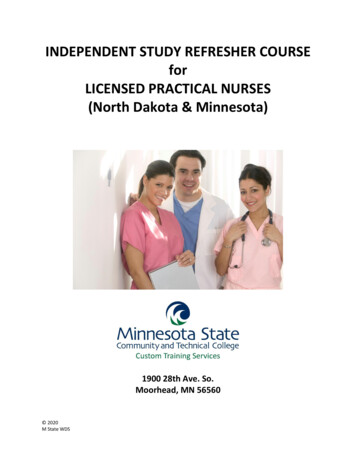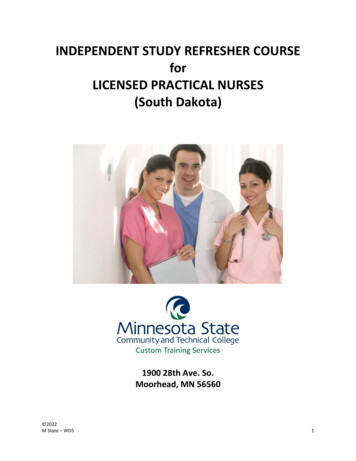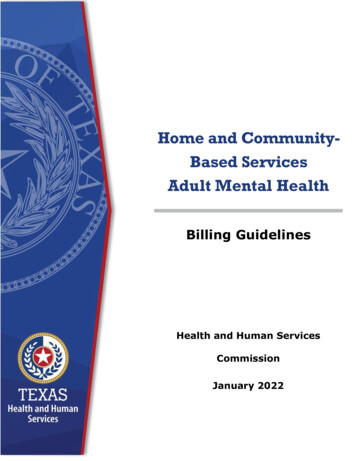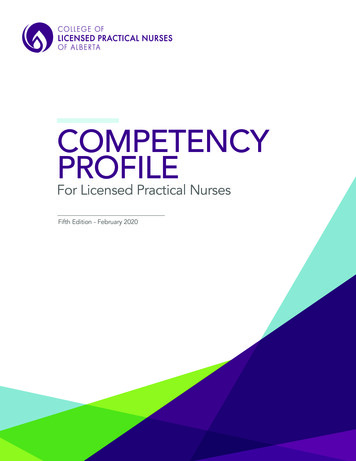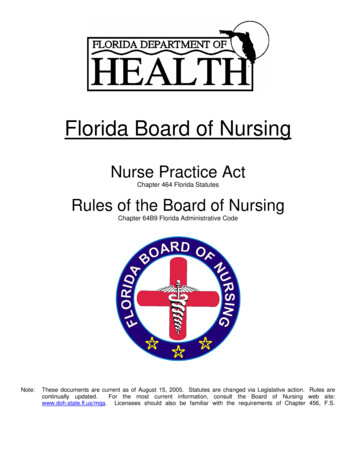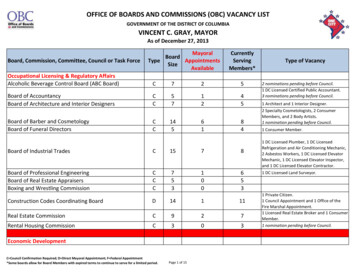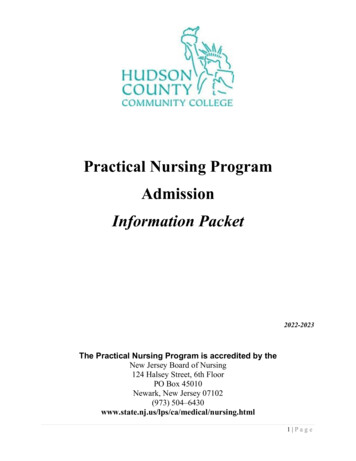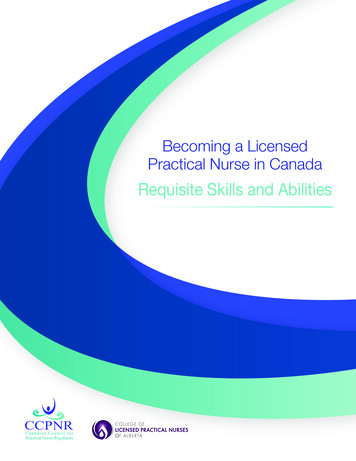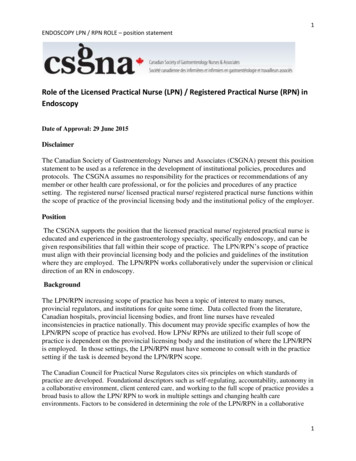
Transcription
1ENDOSCOPY LPN / RPN ROLE – position statementRole of the Licensed Practical Nurse (LPN) / Registered Practical Nurse (RPN) inEndoscopyDate of Approval: 29 June 2015DisclaimerThe Canadian Society of Gastroenterology Nurses and Associates (CSGNA) present this positionstatement to be used as a reference in the development of institutional policies, procedures andprotocols. The CSGNA assumes no responsibility for the practices or recommendations of anymember or other health care professional, or for the policies and procedures of any practicesetting. The registered nurse/ licensed practical nurse/ registered practical nurse functions withinthe scope of practice of the provincial licensing body and the institutional policy of the employer.PositionThe CSGNA supports the position that the licensed practical nurse/ registered practical nurse iseducated and experienced in the gastroenterology specialty, specifically endoscopy, and can begiven responsibilities that fall within their scope of practice. The LPN/RPN’s scope of practicemust align with their provincial licensing body and the policies and guidelines of the institutionwhere they are employed. The LPN/RPN works collaboratively under the supervision or clinicaldirection of an RN in endoscopy.BackgroundThe LPN/RPN increasing scope of practice has been a topic of interest to many nurses,provincial regulators, and institutions for quite some time. Data collected from the literature,Canadian hospitals, provincial licensing bodies, and front line nurses have revealedinconsistencies in practice nationally. This document may provide specific examples of how theLPN/RPN scope of practice has evolved. How LPNs/ RPNs are utilized to their full scope ofpractice is dependent on the provincial licensing body and the institution of where the LPN/RPNis employed. In those settings, the LPN/RPN must have someone to consult with in the practicesetting if the task is deemed beyond the LPN/RPN scope.The Canadian Council for Practical Nurse Regulators cites six principles on which standards ofpractice are developed. Foundational descriptors such as self-regulating, accountability, autonomy ina collaborative environment, client centered care, and working to the full scope of practice provides abroad basis to allow the LPN/ RPN to work in multiple settings and changing health careenvironments. Factors to be considered in determining the role of the LPN/RPN in a collaborative1
2ENDOSCOPY LPN / RPN ROLE – position statementpractice setting include, staffing levels and skill mix, number and acuity of patients, and unit layoutand technology.National examples of the evolution of LPN/RPN scope of practice in the endoscopy setting:In Alberta, there are few restrictions on medication administration, allowing the employerflexibility in policy development to decide what is deemed appropriate. The LPN withspecialized clinical competency can perform the task of Direct IV Push. This is considered anadditional competency education by the employer and specific only to the clinical settingwhere the competency has been achieved (College of Licensed Practical Nurses of Alberta,email communication, Findlay, L., 2015). The additional competency of direct IV push mustbe supported through policy, procedure, education, including lab, theory, and clinicalsupports to ensure safe practice (CLPNA, Bateman, T., 2008).By 2010, graduates of LPN programs in Alberta will have completed basic competency inintravenous initiation (CLPNA, Bateman, 2009).The LPN works under the direction of the registered nurse or physician, is accountable fortheir actions, is aware of licensure, legislation and legal requirements of scope of practice,demonstrates sound knowledge, provides safe competent care, and effective communication.To work in endoscopy, the LPN must have medication therapy, infusion therapy, and adultphysical assessment certifications, and can provide Direct IV push with specializedcompetency with the exception of sedative agents (Covenant Health, 2015). An LPN cannotinitiate a blood transfusion however can provide patient and blood verification as the secondsignature (AHS, 2014).In Ontario, RPNs are involved in the admission, intra-procedure and post proceduresedation care of the endoscopy patient. Some of the tasks include history taking, initiatingintravenous, and procedure room set up, snaring and biopsy, and wire cannulation, injectionof contrast dye, and saline during ERCP procedures (personal communication, DB, 2015).In another site in Ontario, RPNs assist with ERCPs, epinephrine injection to bleeding sites,Botox injections, Kenolog injections, stent insertions, bronchoscopies, variceal gluing, PEGinsertions, call back cases, admission, IV medications (no direct IV push), monitoring ofunsedated patients with RN flexible sigmoidoscopy program. Staffing mix includes 1 RN and1 RPN per procedure room, 1 RN and 1RPN in the admitting area and RNs only in recovery(personal communication, JM, 2015).In New Brunswick, the LPN works in a collaborative role with registered nurses in prep andrecovery. They will also obtain supplies, transportation of patients, bedside pre-cleaning ofscopes. At another NB site, the LPN functions in an endoscopy technician role while an RN ispresent to monitor the patient and administer sedation medication (personal communication,CC, 2015).In Newfoundland, the LPN is counted as the second health care professional. Theyparticipate in biopsy and snaring of small polyps and equipment retrieval. The LPN2
3ENDOSCOPY LPN / RPN ROLE – position statementparticipates in call back as the second nurse with urgent cases performed in the supportedenvironment of the emergency room or intensive care setting. The LPN does not participatein ERCP procedures (personal communication, MC, 2015).In Prince Edward Island, the LPN is involved in the admission process including patientteaching, assessment, and intravenous initiation. They may be called into the procedure roomfor repositioning of patient only (personal communication, PT, 2015).The Endoscopy LPN/RPN must be accountable, competent and knowledgeable in, but notlimited to:1. Anatomy, physiology and pathophysiology of the gastrointestinal tract, including both upper andlower diseases.2. Indications, contraindications, complications of all performed endoscopy procedures.3. Able to apply critical thinking skills, anticipate and manage any complications that may arise andnotify RN or physician of a change in patient health status.4. Patient preparation (teaching, health assessment skills, nursing history, establishing intravenous)during the pre procedure period.5. Familiarity and proper use of equipment intra-procedure.6. Maintenance infection prevention and control practices, proper use of PPE (personal protectiveequipment), awareness of clean and dirt separation, and sterile technique when appropriate.7. Monitoring of the patient during the post procedure period. Knowledge of airway management,recognize potential complications and can administer oxygen therapy via nasal cannula, non-rebreather, bag-mask device, and oral pharyngeal airway if needed. The LPN should also be able torecognize abnormal vital signs and post procedure issues and report them immediately to the RN orphysician.8. Knowledge of medications specific to area of practice, indications, contraindications, side effects,and reversal agents. The LPN/ RPN cannot give procedural sedation by direct IV push.9. Documents patient information according to department guidelines and institutional policies.10. Provides effective communication among the endoscopy team.11. Acts as a resource, patient advocate, and participates in quality management initiatives.12. Participates in educational activities relevant to gastroenterology and endoscopy.13. Cardio-Pulmonary Resuscitation and use of an Automated External Defibrillator.Practice limitations (Depending on licensing jurisdiction):3
4ENDOSCOPY LPN / RPN ROLE – position statementThe LPN/RPN DOES NOT participate in:1. Direct IV procedural sedation (all jurisdictions).2. Administration of blood and blood products (but can perform blood check and monitor patientduring transfusion).3. Administration of radiopaque dyes via parenteral instillation.4. Insertion of tubes beyond the nares (example naso-gastric/ oro-gastric tubes).5. Insertion or advancement of endoscope.6. Monitoring of the patient intra-procedure while under procedural sedation (but can monitor the unsedated patient).7. Applying electricity for the purpose of cauterizing tissue (exception- Automated externaldefibrillator).8. Apply lasers to cut or destroy tissue.The ability to perform to full scope of practice in a specialty is defined by:The education, experience, and competence of the health care professionalEducation module, written exam and practical assessment of skill is recommended.Continuing competency testing of skill is the responsibility of the employer or the facility inwhich the restricted activity is performed.Care needs of the clientSupport available in the clinical area of endoscopyThe ability to work within clear guidelines, and job description to eliminate role ambiguityThe Licensed Practical Nurse/ Registered Practical Nurse is accountable for the responsibilitieshe/she accepts.Staffing levels and mix are dependent on the unit layout, number and type of procedures, and patientacuity. The CSGNA supports the SGNA recommendations of:1 RN in the pre-procedure area1 RN to each procedure room for sedation and patient monitoring. An exception to this wouldbe if an anesthesiologist is monitoring the patient and providing sedation.1 RN in the post procedure areaDuring therapeutic or unstable cases, 1 RN and 1 other health care professional should beavailable during the procedure. This can be another RN or LPN/ RPN. Other members of the4
5ENDOSCOPY LPN / RPN ROLE – position statementhealth care team such as respiratory therapist, anesthesiologist, or the critical care team arenot to be counted as part of the two endo team members during an UNSTABLE case. TheLPN/RPN DOES NOT care for an unstable patient in an UNPREDICATABLEENVIRONMENT.DefinitionsLicensed Practical Nurse/ Registered Practical Nurse- is a nurse that work collaboratively, andunder the direction of an RN or physician. LPNs/RPNs work within their own scope of practice,standards of practice and code of ethics.Registered Endoscopy Nurse-A nurse with a diploma or undergraduate degree working in aspecialized area such as endoscopy.Advanced Nursing Practice- A graduate degree nurse such as a Nurse Practitioner working in aspecialized area of practice.Scope of Practice- is the knowledge of registered nurses/ licensed practical nurses/ registeredpractical nurses and the comprehensive application of said knowledge to meet the client’s healthcare needs in any healthcare setting, and complexity throughout the lifespan of the client. Scopeof practice includes all interventions that the nurse is regulated, educated and competent toperform.Continuing Competence- provincial/ territorial nursing associations and employers havecontinuing competency frameworks to ensure nurses maintain competency requirements on anannual basis prior to renewal of registration and licensing.Additional competency- this competency is termed appropriate to the increased scope of practicefor the LPN and only when supported in a specific practice setting through policy, procedure,education, learning modules, labs, and clinical supports to evaluate safe practice of said specificcompetency.Restricted Activities- are high risk activities performed as part of a health service requiringspecific competencies and skills to be carried out in a safe, controlled manner. They are notlinked to any specific health profession and a number of regulated health care practitioners mayperform the restricted activity.Therapeutic endoscopy procedure- may include but is not limited to: removal of foreign bodies;hemostasis by hemoclips placement, injection of drugs, thermal coagulation, laserphotocoagulation, variceal banding, or sclerotherapy; debulking of tumors by laser or bipolarelectrocoagulation; ablative therapy of premalignant lesions; dilation of webs or strictures; stentplacement; reduction of volvulus or intussusception; decompression of acute or subacute colonicdilatation; and feeding tube placement.5
6ENDOSCOPY LPN / RPN ROLE – position statementReferencesAlberta Health Services (2014). University of Alberta Hospital/ Mazankowski Alberta HeartInstitute, operative services, standards of practice. Retrieved fromwww.albertahealthservices.ca/insiteAmerican Society of Gastoroenterology Endoscopy (2014). Guidelines for safety in thegastrointestinal endoscopy unit. Gastrointestinal Endoscopy, 79(3), 363-371.doi: 10.1016/j.gie.2013.12.015Annapolis Valley Health (2015). LPN Endoscopy-Nova Scotia. Retrieved n-endoscopyCanadian council for Practical Nurse Regulators (2013). Standards of licenced practical nurses inCanada. Retrieved from www.ccpnr.caCanadian Nurses Association (2006). Canadian regulatory framework for registered nurses.Retrieved from www.cna-aiic.caCollege of Licensed Practical Nurses of Alberta (2009). Practice memo: mandatory educationand continuing competency education information. Retrieved from www.clpna.comCollege of Licensed Practical Nurses of Alberta (2008). Practice memo: change in scope ofpractice- medications by intravenous push. Retrieved from www.clpna.comCollege of Licensed Practical Nurses of Alberta & Alberta Health (2005). Competency profilefor licensed practical nurses, pg 1-322. Retrieved from www.clpna.com/wpcontent/uploads/2013/02/doc AB LPN competency profile 2nd%20Edition.pdfCollege of Licensed Practical Nurses of BC (2014). Scope of practice for licensed practicalNurses. Retrieved from www.clpnbc.orgCollege of Licensed Practical Nurses of British Columbia (2013). CLPNBC limits andconditions for acting with clinical guidance. Retrieved endix.aspxCovenant Health (2015). Licensed Practical Nurse position description. Retrieved fromwww.compassionnet.caDepartment of Health Nursing Care Quality Assurance Commission (2015). Administrationof sedating, analgesic, and anesthetic agents. Retrieved nestheticAgents.pdf6
7ENDOSCOPY LPN / RPN ROLE – position statementGovernment of Alberta (2015). Health professions act: province of Alberta, 1-312. RetrievedFrom on, P. (2011). Staffing the endoscopy department: what is the appropriate skill mix?Gastrointestinal Nursing, 9(1), 28-33. No doi.Shimoni, R., Barrington, G (2012), College of Licensed Practical Nurses of Alberta (2013),amended. Understanding licensed practical nurses full scope of practice research study.Retrieved from www.clpna.com/wpcontent/uploads/2013/02/doc understanding LPNs Full Scope of practice research Final Report 11.pdfSociety of Gastroenterology Nurses and Associates (2014). Standards of clinical nursing practiceand role delineations. Pg 1-25. Retrieved from www.sgna.orgSociety for Gastroenterology Nurses and Associates (2012). Position statement: role delineationOf the licensed practical nurse/ vocational nurse in Gastroenterology. Retrieved fromwww.sgna.org/Portals/0/Issues/SGNA Position statement LPN Role.pdfSociety of Gastroenterology Nurses and Associates (2012). Position statement: minimumregistered nurse staffing for patient care in the gastrointestinal endoscopy unit. on/Practice%20Guidelines/SGNA Minimum RNStaffing.pdf7
8ENDOSCOPY LPN / RPN ROLE – position statement8
9ENDOSCOPY LPN / RPN ROLE – position statement9
LPN/RPN DOES NOT care for an unstable patient in an UNPREDICATABLE ENVIRONMENT. Definitions Licensed Practical Nurse/ Registered Practical Nurse-is a nurse that work collaboratively, and under the direction of an RN or physician. LPNs/RPNs work within their own scope of practice, standards of practice and code of ethics.



